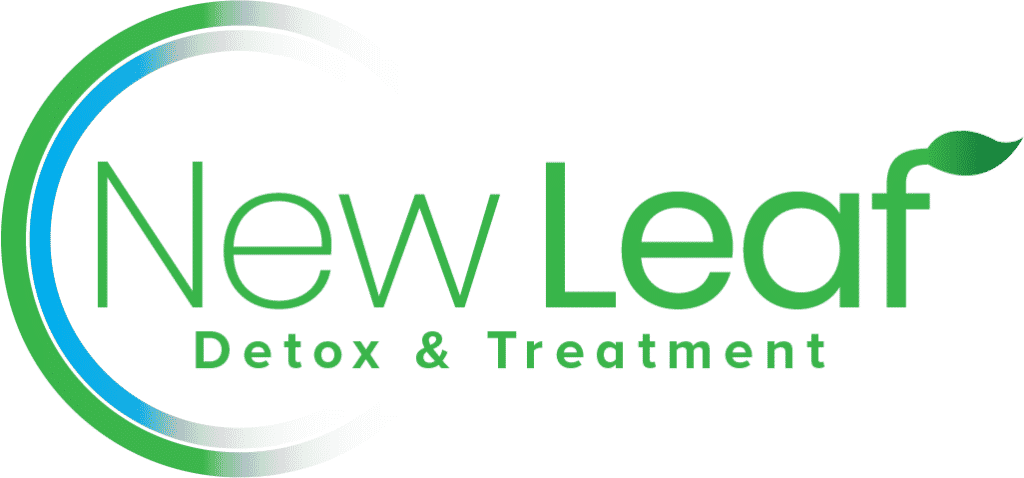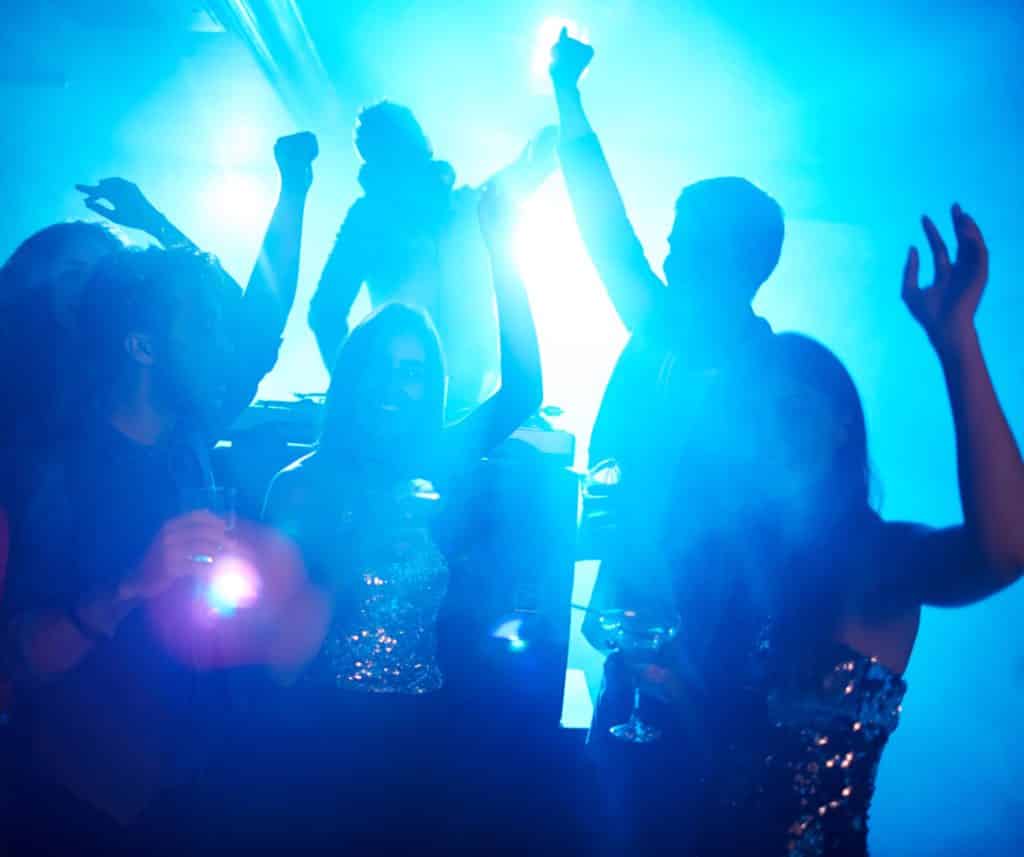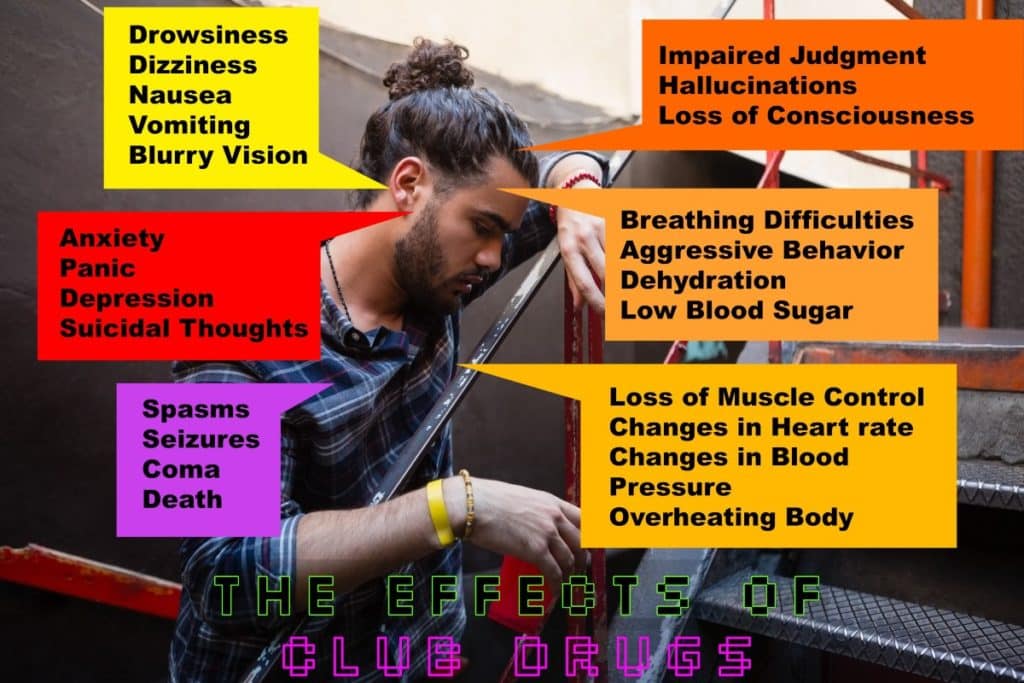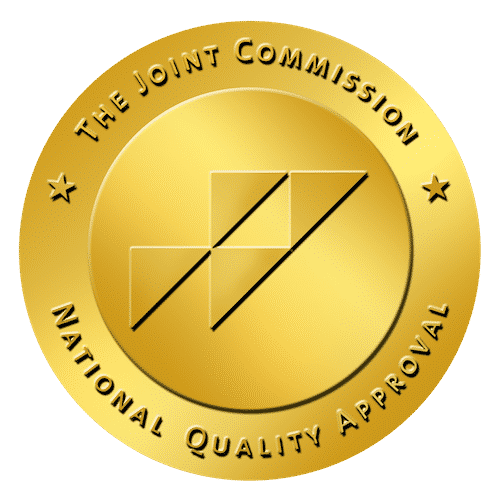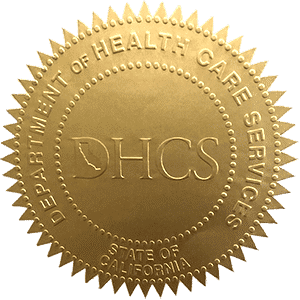Club Drugs:
Nothing To 'Rave' About
is the first step to recovery
Disclaimer: Only for fair use for educational purposes and illustration. We do not own the copyright to this video.
Introduction
Party drugs, or club drugs, conjure up images of youth, music, hedonism, sexuality, and fun—the proverbial “sex, drugs, and rock and roll”. Recreational drug use was epitomized by the counterculture movement of the 60s and 70s that spawned from a mix of youthful idealism, disillusionment, and anger over racial disparity, the Kennedy assassinations, the Vietnam War, and defiance against government.
It was writ large at Woodstock, the outdoor music festival that took place over three days in the summer of 1969 in upstate New York that was attended by more than 400,000 young Americans. That origin story evolved over time into the house party scene, raves, and club drugs that sprung up in Europe to today’s recreational drug culture in the US of party and club drugs.
The popular substances of the first wave of party drugs, three decades before the advent of potent and lethal manufactured street opioids, were either relatively benign drugs like marijuana, opium, LSD, and mushrooms. The effects of the drugs of that period, many psychedelic, were hyper visuality and auditory awareness, altered and amplified emotional and physical sensations, and warped perceptions beyond the ordinary that enhanced the experience of listening to live music in a communal setting of like-minded young people.
Despite the large number of people attending the drug-riddled gathering at Woodstock, there were only 700 drug overdoses, and only three of them were fatal. The perceptions of luxury, exclusivity, tribalism, sexuality, and safety of use associated with those drugs lingered. But these perceptions are inapplicable to the club and party drug scene of today that is awash in cheap manufactured drug cocktails originating from underground labs in China and Mexico.
Party/Club Drugs Today
The most popular club drugs today are formulations and compounds created from synthetic analogs of controlled substances. Many of these drugs are manufactured in specific iterations and formulas with potent chemicals and cheap fillers. An array of “designer drugs” are formulated to escape legal regulation, evade interdiction and law enforcement seizure, and override detection in routine drug testing.
Dangerous Ingredients
To increase the bottom line in drug dealing, many illicit labs and drug dealers spike, adulterate or cut club drugs with cheaper ingredients to control costs, drive larger profit margins, or yield potency and create addiction among users.
Because synthesizing MDMA is a highly complicated chemical process involving hard-to-procure chemical ingredients that requires technical expertise, it is rarely found in MDMA samples. Instead, illicit drug makers frequently cook meth from readily available household disinfectants and cough syrup, label it as MDMA, and sell them to dealers.
In the case of LSD which also requires advanced knowledge in chemistry, underground labs simply substitute veterinary tranquilizers and market fake LSD. Cutting higher-priced ingredients and bulking up capsules and tablets with fillers such as caffeine, milk powder, glucose, or sucrose are common practice. Frequently lower potency drugs such as marijuana are adulterated with dangerous drugs such as PCP or fentanyl to amplify the drug high.
Overdose deaths from club drugs are no longer rare. In 2020, 19-year-old Katie Dix ingested what she thought was MDMA at the Hard Summer Music Festival in Pomona, CA and died from its use. A toxicology report found MDMA and Ethylone, a so called “designer drug” colloquially called “bath salt” that increases the potency of MDMA. Club drugs spiked or adulterated with dangerous chemicals such as PCP, meth, and fentanyl can lead to certain addiction and immediate or eventual death, and a mixture of caffeine with sodium benzoate.
Club Drugs Profile
The power and potency of the new class of manufactured and synthetic club and party drugs, commonly ingested today, often mean that recreational use is no longer contained.
These psychoactive drugs target the central nervous system to alter cognitive function, destabilize emotions, and cause changes in perception, awareness, and behavior.
Hallucinogens
Hallucinogens warp the mind, making users confused about reality and perceived reality and causing fantasy and vivid hallucinations. People who use hallucinogens often report being transported to other realms, having near death experiences that are either spiritual or hellish, losing sense of time, and blacking out.
Stimulants
Stimulants create excitability and intensity of feelings as well as create hyper-emotional and physical arousal. They lower inhibitions and can cause users to act recklessly or do things they normally wouldn’t do. Some stimulants cause fear, paranoia, and anxiety.
Depressants
Depressants, on the other hand, act on the nervous system resulting in impaired physical reaction, muddled cognitive function, and flat emotions. They can be extremely potent, severely addictive, and frequently fatal.
Types of Party Drugs
For information on alcohol’s health effects, please visit the National Institute on Alcohol Abuse and Alcoholism (NIAAA) website.
A tea made in the Amazon from a plant (Psychotria viridis) containing the hallucinogen DMT, along with another vine (Banisteriopsis caapi) that contains an MAO inhibitor preventing the natural breakdown of DMT in the digestive system, which enhances serotonergic activity. It was used historically in Amazonian religious and healing rituals. For more information, see the Hallucinogens and Dissociative Drugs Research Report.
A powerfully addictive stimulant drug made from the leaves of the coca plant native to South America. For more information, see the Cocaine Research Report.
Medications that slow brain activity, which makes them useful for treating anxiety and sleep problems. For more information, see the Misuse of Prescription Drugs Research Report.
Dimethyltriptamine (DMT) is a synthetic drug that produces intense but relatively short-lived hallucinogenic experiences; it is also found naturally in some South American plants (see Ayahuasca). For more information, see the Hallucinogens and Dissociative Drugs Research Report.
Gamma-hydroxybutyrate (GHB) is a depressant approved for use in the treatment of narcolepsy, a disorder that causes daytime “sleep attacks”.
Drugs that cause profound distortions in a person’s perceptions of reality, such as ketamine, LSD, mescaline (peyote), PCP, psilocybin, salvia, DMT, and ayahuasca. For more information, see the Hallucinogens and Dissociative Drugs Research Report.
An opioid drug made from morphine, a natural substance extracted from the seed pod of various opium poppy plants. For more information, see the Heroin Research Report.
Solvents, aerosols, and gases found in household products such as spray paints, markers, glues, and cleaning fluids; also prescription nitrites. For more information, see the Inhalants Research Report.
A dissociative drug used as an anesthetic in veterinary practice. Dissociative drugs are hallucinogens that cause the user to feel detached from reality. For more information, see the Hallucinogens and Dissociative Drugs Research Report
Pronounced “cot,” a shrub (Catha edulis) found in East Africa and southern Arabia; contains the psychoactive chemicals cathinone and cathine. People from African and Arabian regions (up to an estimated 20 million worldwide) have used khat for centuries as part of cultural tradition and for its stimulant-like effects.
A hallucinogen manufactured from lysergic acid, which is found in ergot, a fungus that grows on rye and other grains. LSD is an abbreviation of the scientific name lysergic acid diethylamide. For more information, see the Hallucinogens and Dissociative Drugs Research Report.
Marijuana is made from the hemp plant, Cannabis sativa. The main psychoactive (mind-altering) chemical in marijuana is delta-9-tetrahydrocannabinol, or THC. For more information, see the Marijuana Research Report.
A synthetic, psychoactive drug that has similarities to both the stimulant amphetamine and the hallucinogen mescaline. MDMA is an abbreviation of the scientific name 3,4-methylenedioxy-methamphetamine. For more information, see the MDMA (Ecstasy) Abuse Research Report.
A hallucinogen found in disk-shaped “buttons” in the crown of several cacti, including peyote. For more information, see the Hallucinogens DrugFacts.
An extremely addictive stimulant amphetamine drug. For more information, see the Methamphetamine Research Report.
Psychoactive when taken in higher-than-recommended amounts. For more information, see the Over the Counter Medicines DrugFacts.
An anti-diarrheal that can cause euphoria when taken in higher-than-recommended doses. For more information, see the Over the Counter Medicines DrugFacts.
A dissociative drug developed as an intravenous anesthetic that has been discontinued due to serious adverse effects. Dissociative drugs are hallucinogens that cause the user to feel detached from reality. PCP is an abbreviation of the scientific name, phencyclidine. For more information, see the Hallucinogens and Dissociative Drugs Research Report
Pain relievers with an origin similar to that of heroin. Opioids can cause euphoria and are often used nonmedically, leading to overdose deaths. For more information, see the Misuse of Prescription Drugs Research Report.
Medications that increase alertness, attention, energy, blood pressure, heart rate, and breathing rate. For more information, see the Misuse of Prescription Drugs Research Report.
A hallucinogen in certain types of mushrooms that grow in parts of South America, Mexico, and the United States. For more information, see the Hallucinogens and Dissociative Drugs Research Report.
A benzodiazepine chemically similar to prescription sedatives such as Valium® and Xanax® that may be misused for its psychotropic effects. Rohypnol has been used to commit sexual assaults because of its strong sedation effects. In these cases, offenders may dissolve the drug in a person’s drink without their knowledge.
A dissociative drug (Salvia divinorum) that is an herb in the mint family native to southern Mexico. Dissociative drugs are hallucinogens that cause the user to feel detached from reality. For more information, see the Hallucinogens and Dissociative Drugs Research Report.
A wide variety of herbal mixtures containing man-made cannabinoid chemicals related to THC in marijuana but often much stronger and more dangerous. Sometimes misleadingly called “synthetic marijuana” and marketed as a “natural,” “safe,” legal alternative to marijuana. For more information, see the Synthetic Cannabinoids DrugFacts.
An emerging family of drugs containing one or more synthetic chemicals related to cathinone, a stimulant found naturally in the khat plant. Examples of such chemicals include mephedrone, methylone, and 3,4-methylenedioxypyrovalerone (MDPV). For more information, see the Synthetic Cathinones DrugFacts.
Tobacco is a plant grown for its leaves, which are dried and fermented before use. Tobacco contains nicotine, an addictive chemical. Nicotine is sometimes extracted from the plant and is used in vaping devices. For more information, see the Tobacco, Nicotine and E-Cigarettes Research Report.
The most widely available and consumed club drugs are familiar to many by their popular names:
Ecstasy
Ecstasy or molly are street names for methylenedioxymethamphetamine or MDMA. It is the most popular club drug that creates a sense of euphoria and amplifies the sounds and lights at a musical performance. It is also the drug that causes the most number of deaths at music festivals. Overdosing on MDMA causes an alarming increase in body temperature leading to hyperthermia.
GHB
Gamma-hydroxybutyrate or GHB is referred by the street names G or Liquid Ecstasy.
Ketamine
Ketamine, a medical-grade drug that is used as veterinary anesthesia causes drowsiness, relieves pain, and wipes out memory. Overdosing causes people to disassociate from reality and enter a near-catatonic state and immobility. It is known as K or Special K in the party drug eco-system and overdosing is often referred to as the “K Hole.”
Roofies
Flunitrazepam (roofies) is prevalent in club drug culture.
LSD
Lysergic Acid Diethylamide or LSD, the psychedelic drug of the counter culture, remains evergreen in the party drug scene and is simply known as acid. It distorts and alters thought-processing and makes people zoom in on individual, granular, micro thoughts such as a blade of grass or a drop of water.
Mushrooms
Magic mushrooms and other hallucinogens warp and distort thought patterns and enhance the experience of sounds and colors. Each year, more than 8,000 people end up in hospital emergency rooms due to overdose on hallucinatory drugs.
Effects of Club Drugs
Club drugs are deceptive in appearance. Many look like prescription medicines which give a false sense of security to users. Meth is highly addictive. It is also used as a cutting agent or filler in other club drugs like GHB, ketamine, and fluitrazepam. They can addle the brain as well as the central nervous system and have dire consequences to the body and user.
The effects of these drugs can be swift or prolonged, over an extended period, and depending on the user’s own body and health condition, the type of drug, its contraindications with other medications, and the quantity of drug ingested. Within 20 minutes of ingestion, the user may begin to feel a cascading wave of symptoms, either separately, or together, following one after the other, or in clusters.
Most overdoses occur because of unknown spiked or adulterated drug formulations, or ingesting multiple types of drugs of known or unknown formulas, or in combination with alcohol. When those who ingest club drugs are rushed to hospital emergency rooms, medical teams face difficulties treating them because of the lack of knowledge of the ingested substances.
Club Drugs as Date Rape Drugs

Many of the popular club drugs are colorless, tasteless, and odorless which allow sexual predators to prey users or spike their drinks to render them immobile or unconscious in order to commit sexual assault. Basic measures to ensure personal safety that can stop sexual predators from using date rape drugs include:
- Consuming food and drinks you break open yourself.
- Monitoring your drinks or holding them at all times.
- Rejecting drinks from people you don’t know.
- Have a reciprocal buddy system to watch over unattended drinks.
From Recreation To Addiction
The path from recreational use of club drugs to addiction is inevitable. They have adverse and acute clinical, psychiatric, and physiologic outcomes for those who ingest them.
These potent drugs of unknown ingredients are a proverbial game of Russian Roulette. No one knows what toxic ingredients are in the bullets, and no one knows which bullet will be the fatal one.
Recovery at New Leaf Detox & Treatment
The field of addiction medicine is racing to produce drugs that prevent or decrease the chances of relapse. While experimental drugs submit to the rigors and hurdles of clinical trials, discoveries, longitudinal studies, and approval; the gold standard in current treatment offers evidence-based medical, behavioral, and social therapies.
At New Leaf Detox & Treatment, we are committed to meeting the needs of our patients with the most advanced best practices in addiction medicine and treatment and evidence-based standards of care, while always mindful of each client’s individual needs.
After the extensive patient-provider engagement, careful screening, and medical and psychological evaluation, our clinician’s design individualized plans to meet each patient’s specific needs. The plans are comprehensive in scope using a variety of treatment modalities from our cornucopia of specialized care plans that include Medication Assisted Treatment.
New Leaf’s Medication Assisted Treatment plans for best client outcomes to feature three of the four FDA Approved MAT drugs: Buprenorphine, its extended-release injection Sublocade, and Naltrexone. These three MAT regimens and protocols have high success rates for clients when complemented with counseling and psychosocial support.
The patient begins cognitive-behavioral treatment with an individual therapist as well as in groups with a counselor to address the whole host of issues afflicting the patient, including anxiety disorders. Psychotherapy plans and specific treatment modalities tailored for the patient include individual counseling, group counseling, anxiety-focused therapy groups, and process groups and activities.
The primary clinician and individual therapist and group counselor work in concert to treat the patient by resolving the underlying issues that led to addiction, followed by a variety of custom treatments that fortify the patient, clinical assessments throughout the process, and a considered discharge plan. Peer support, onsite medical assistance, family involvement, and post-treatment follow-up support are part of New Leaf’s standard of care.
For more information please contact:
New Leaf Detox and Treatment, San Juan Capistrano, CA.
Sources
- Bowden-Jones, Owen; Abdulrahim, Dima (2020).Part I – Introduction: What Are Club Drugs and NPS and Why Are They Important?
- Club Drugs. DrugAbuse.gov. North Bethesda, Maryland: National Institute on Drug Abuse. 2021. Retrieved 17 August 2021.
- Club Drugs: Medline Plus. MedlinePlus.gov. Archived from the original on 22 December 2017. Retrieved 22 March 2018.
- What Are Club Drugs? Effects, Types, List of Street Names. eMedicineHealth.com. Archived from the original on 16 September 2015. Retrieved 22 March 2018.
- Pulse Check – Winter 1995 (National Drug Control Policy). Archived from the original on 2008-06-08. Retrieved 2008-06-23.
- Club Drugs and Their Effects. Narconon International. Archived from the original on 31 January 2018. Retrieved 22 March 2018.
- Director’s Report to the National Advisory Council on Drug Abuse. National Institute on Drug Abuse. May 2000. Archived from the original on 3 February 2016.
- World Health Organization (2004). Neuroscience of psychoactive substance use and dependence. p. 89. ISBN 9789241562355.
- Psychedelic drugs induce ‘heightened state of consciousness’, brain scans show. Archived 2017-04-24 at the Wayback Machine, guardian.com. Retrieved: 23 April 2017.
- Giannini, A. J. (1991). “Volatiles”. In Miller, N. S. (ed.). Comprehensive Handbook of Drug and Alcohol Addiction. New York City: Marcel Dekker. p. 396. ISBN 978-0-8247-8474-4. S2CID 142846805.
- Cocaine: How It Works, Effects and Risks. webmd.com. Archived from the original on 27 February 2014. Retrieved 22 March 2018.
